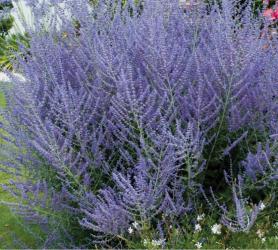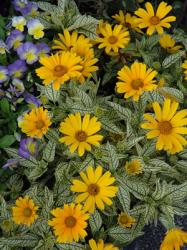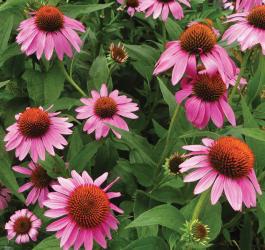Stokesia, also known as Stoke's Aster, provided by Ann Lapides
Water
Although drought-tolerant, give constant moisture for prime flowering.
Soil
Average, well-drained soil.
Location + Light
Requires at least 6 hours of full sun.
Drainage
Though it loves constant moisture, too much water will stifle growth. Place in a well-drained area of the garden.
DIVIDING Tips
Divide every three to four years, yielding the best results in early fall.
Fertilizer
Fertilize with a granular fertilizer in spring to help the plant grow larger roots. This promotes more flower growth.
Winning a top spot on our perennial favorite's list, the vibrant Stokesia adorns the garden with enormous, periwinkle-blue 4-inch blooms. The blossoms are held high and flat on strong stems, making them perfect for cutting. It begins its prolific blooming in June, with continual waves of flowers through August. Magnificent in full display, it will have hundreds of its jewel-toned blossoms appearing at the same time. Stokesia makes a great companion to other sun perennials, including yellow tickseed, red and pink bee balms and showy coneflowers.
The trustworthy Russian Sage perennial has many favorable characteristics; it’s a great staple for every garden. Not only is it drought-tolerant once it’s established, it is also a longtime bloomer in summer and fall. We love Russian Sage because it’s very deer resistant, and we are confident in recommending it for your sunny garden beds. Bridget Clancy, Zick’s Great Outdoors.
New Day Rose Stripe Gazania. This stunning annual blooms from late spring into summer. This is a favorite due to the numerous vibrant colors, from the bright yellow-orange eye to the magenta petals with bright white margins. These gazanias will brighten up any landscape or garden! Chesterfield Valley Nursery.
Heliopsis “Sunstruck” is a showy and reliable sun-loving perennial featuring variegated foliage and a large, deep yellow flower. Its short, compact nature makes it a great addition to the smaller garden, in the front of the border or even in containers. Keep it deadheaded and it will bloom late into fall. M.A. Ward, Timberwinds Nursery.
A native Missouri coneflower, Echinacea Purpurea does well in the varying climate. It is very easy to grow in full sun or light shade. It has a long bloom time, makes a great cut flower and is an excellent source of nectar for butterflies. It is perfect for both small gardens and large prairie meadows. Anne Deutch, Garden Heights Nursery.
The Asiatic Lily “Landini” is the darkest Lily you will find with prolific, deep midnight-red flowers. These summer bloomers grow to be over 4 feet tall, and their long stems make them excellent cut flowers. It is ideal for containers, but be sure it is well watered and in a sunny location. Sarah Riley, Bowood Farms.
Also called Hyssop or Hummingbird’s Mint, the Agastache comes in yellow, purple, orange and coral. This plant is in the mint family and has a nice fragrance to attract butterflies and hummingbirds (but not rabbits or deer). Most selections are a nice, compact size, and can tolerate full sun in dry to medium soil. This works great for a border or in pots. Kate Nevins, Kirkwood Gardens.















